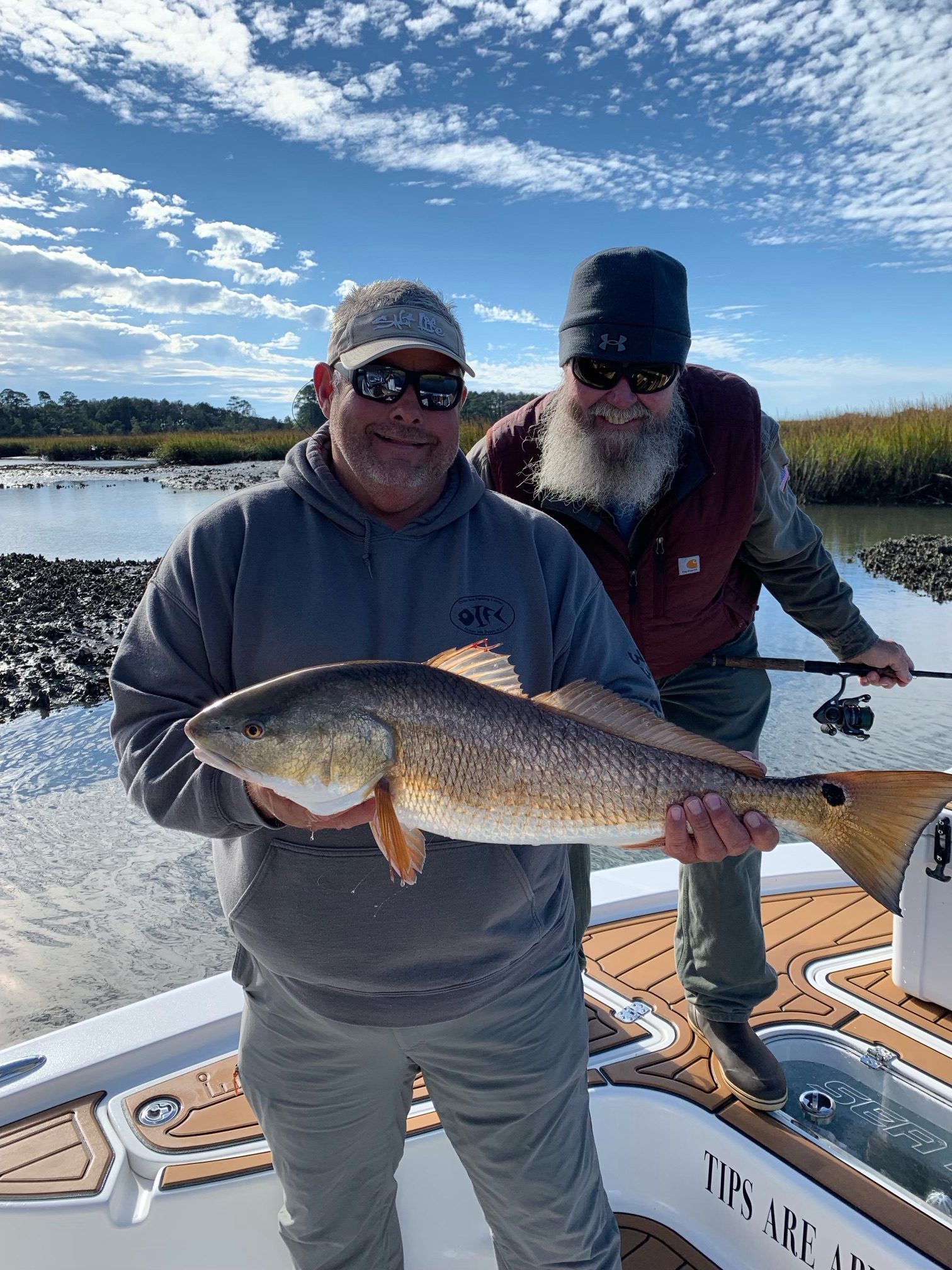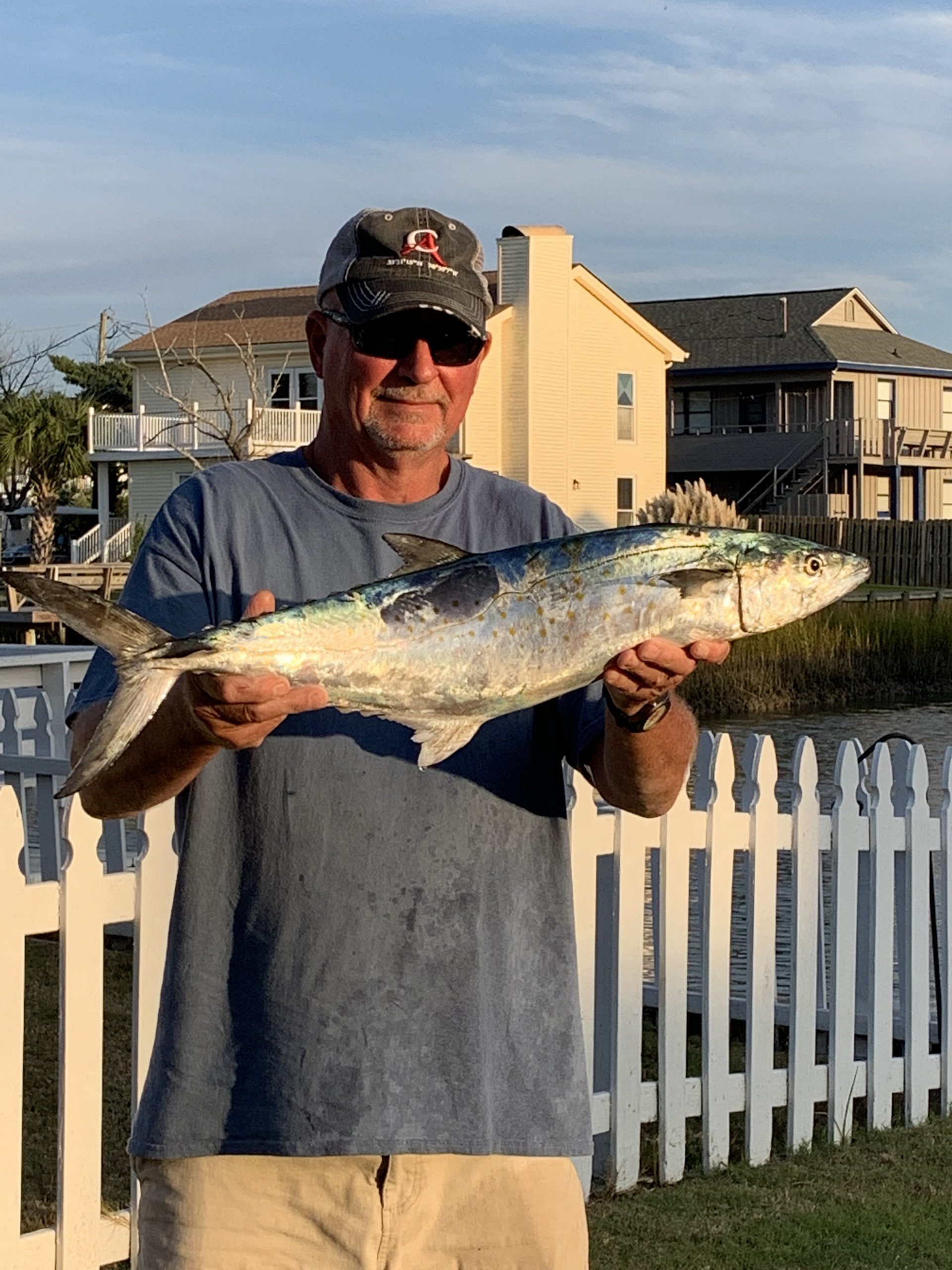North Myrtle Beach/Little River – December 2021
Patrick, of Captain Smiley Fishing Charters, reports that water temperatures dropping into the upper 50s has speckled trout fishing on fire on the north end of the Grand Strand.
The bite has been best on the lower and incoming tide cycles, with current (going either way) being the most important factor. There just isn’t much feeding action during the slack tide periods.
The good target areas have been shell beds and grass edges along the ICW with around 6’ of water. Live shrimp has been the top producing bait, with anglers also having success with D.O.A. soft plastics and Vudu shrimp in the chartreuse color pattern.
Redfish have mostly moved into the mainland creeks where the bite has been strong. Both live baits and New Penny-colored Gulp soft plastics are getting strikes.
Inshore anglers are finding some flatfish hanging around when fishing bottom-rigged live mullet and Gulp baits, and some big black drum are feeding on shrimp and crab baits around docks and oyster beds.
Anglers hitting the surf zone are catching whiting, flounder, and some pompano.

David Taylor, of Cherry Grove, SC, with a red drum caught on live mullet while fishing a mud flat in the Little River area. He was fishing wish Capt. Chris Ossmann of Fine Catch Fishing Charters.
Bob, of Strange Magic Fishing Charters, reports that the trout bite has finally kicked into high gear. The larger trout have been hitting a variety of baits, from live shrimp and minnows under popping corks to a mix of artificials. Many fishing techniques can work when targeting trout this time of year, including straight trolling, slow trolling while casting, and anchoring up to fish a particular spot.
For fishing soft plastics on jig heads, match the weight of the jig to the current speed and depth of water. Always aim to use the least weight possible to slow your retrieve. Target shallow areas that have structure and have quick nearby access to deep water. Shell banks along the ICW, creek openings, and grass transition zones near deeper water are great examples of productive trout areas.
Black drum action is also available, especially near holes and docks in the backs of creeks. Fresh shrimp and cut crab sections work well.
Many of the big reds have pushed out to their ocean haunts by now. Anglers that are patient and still motivated can cruise up and down the beach, where large schools can be found just past the breakers.
Flounder are around, but most of the larger fish have gone into the ocean for winter. The nearshore artificial reefs can still be productive with live minnows or heavy jig heads with soft plastic trailers bumped off the bottom.
Going into the winter months, look for schools of juvenile redfish on the inshore flats and larger shallow back creek areas, especially those with mud that the sun will heat up. Drains from backwater marshes on a falling tide are also great spots to focus on.
Larry, of Voyager Fishing Charters, reports that bottom fishing remains good for anglers working structure in the 10+ mile range. A mix of keeper black sea bass and porgies are hitting various cut baits.
Deeper offshore structure (in the 45-mile range) has been producing plenty of good-sized vermilion snapper, grunts, triggerfish, and amberjack, and a few boats taking advantage of the small weather windows are catching some wahoo while trolling out at the Blackjack area.
Cameron, of Little River Fishing Fleet, reports that anglers have been seeing some great bottom fishing on trips to structure in the 25-45 mile range. Some good-sized scamp grouper (to 28 lbs.), gray snapper, large black sea bass, and plenty of beeliners are around feeding on cut baits.
Nearshore structures from 15 miles and out are loaded with smaller, but plenty of, keeper black sea bass.
Trolling from this range and deeper has been producing some large king mackerel and bonita.
The half day trips are finding good numbers of black sea bass, ringtails, and porgies closer to the beaches.
Going into winter, anglers look for bottom fishing to remain good. Black sea bass and vermilion snapper, in particular, are not phased by the conditions and feed aggressively over structure, ledges, and live bottom areas.
King mackerel start to move out by the end of the year, as water temperatures fall out of their preferred range.
Wahoo will be caught by anglers running offshore to fish the temperature breaks.
JT, of Cherry Grove Pier, reports that cooler water temperatures have moved bottom fishing into the limelight. A mix of croakers, whiting, and black drum are all feeding on smaller baits on the classic two-hook bottom rig.
Red drum and a few flounder are also around for anglers fishing cut bait and fresh bait shrimp.
Going into winter, look for whiting and croaker action to continue all the way through. A hopefully mild winter will see better fishing action than if the area sees a succession of cold fronts.
Deborah, of Apache Pier, reports that anglers enjoying the mild early winter days are catching a good mix of croakers, whiting, and black drum.
Days with rougher, stirred up water conditions are also seeing a few red drum in the mix.
, reports that water temperatures dropping into the upper 50s has speckled trout fishing on fire on the north end of the Grand Strand.
The bite has been best on the lower and incoming tide cycles, with current (going either way) being the most important factor. There just isn’t much feeding action during the slack tide periods.
The good target areas have been shell beds and grass edges along the ICW with around 6’ of water. Live shrimp has been the top producing bait, with anglers also having success with D.O.A. soft plastics and Vudu shrimp in the chartreuse color pattern.
Redfish have mostly moved into the mainland creeks where the bite has been strong. Both live baits and New Penny-colored Gulp soft plastics are getting strikes.
Inshore anglers are finding some flatfish hanging around when fishing bottom-rigged live mullet and Gulp baits, and some big black drum are feeding on shrimp and crab baits around docks and oyster beds.
Anglers hitting the surf zone are catching whiting, flounder, and some pompano.
Bob, of Strange Magic Fishing Charters, reports that the trout bite has finally kicked into high gear. The larger trout have been hitting a variety of baits, from live shrimp and minnows under popping corks to a mix of artificials. Many fishing techniques can work when targeting trout this time of year, including straight trolling, slow trolling while casting, and anchoring up to fish a particular spot.
For fishing soft plastics on jig heads, match the weight of the jig to the current speed and depth of water. Always aim to use the least weight possible to slow your retrieve. Target shallow areas that have structure and have quick nearby access to deep water. Shell banks along the ICW, creek openings, and grass transition zones near deeper water are great examples of productive trout areas.
Black drum action is also available, especially near holes and docks in the backs of creeks. Fresh shrimp and cut crab sections work well.
Many of the big reds have pushed out to their ocean haunts by now. Anglers that are patient and still motivated can cruise up and down the beach, where large schools can be found just past the breakers.
Flounder are around, but most of the larger fish have gone into the ocean for winter. The nearshore artificial reefs can still be productive with live minnows or heavy jig heads with soft plastic trailers bumped off the bottom.
Going into the winter months, look for schools of juvenile redfish on the inshore flats and larger shallow back creek areas, especially those with mud that the sun will heat up. Drains from backwater marshes on a falling tide are also great spots to focus on.

Mike Monteith, from Clover, SC, with an 8 lb. spanish (27.5″) caught while trolling a Blue Water Candy spanish rig outside Little River Inlet.
Larry, of Voyager Fishing Charters, reports that bottom fishing remains good for anglers working structure in the 10+ mile range. A mix of keeper black sea bass and porgies are hitting various cut baits.
Deeper offshore structure (in the 45-mile range) has been producing plenty of good-sized vermilion snapper, grunts, triggerfish, and amberjack, and a few boats taking advantage of the small weather windows are catching some wahoo while trolling out at the Blackjack area.
Cameron, of Little River Fishing Fleet, reports that anglers have been seeing some great bottom fishing on trips to structure in the 25-45 mile range. Some good-sized scamp grouper (to 28 lbs.), gray snapper, large black sea bass, and plenty of beeliners are around feeding on cut baits.
Nearshore structures from 15 miles and out are loaded with smaller, but plenty of, keeper black sea bass.
Trolling from this range and deeper has been producing some large king mackerel and bonita.
The half day trips are finding good numbers of black sea bass, ringtails, and porgies closer to the beaches.
Going into winter, anglers look for bottom fishing to remain good. Black sea bass and vermilion snapper, in particular, are not phased by the conditions and feed aggressively over structure, ledges, and live bottom areas.
King mackerel start to move out by the end of the year, as water temperatures fall out of their preferred range.
Wahoo will be caught by anglers running offshore to fish the temperature breaks.
JT, of Cherry Grove Pier, reports that cooler water temperatures have moved bottom fishing into the limelight. A mix of croakers, whiting, and black drum are all feeding on smaller baits on the classic two-hook bottom rig.
Red drum and a few flounder are also around for anglers fishing cut bait and fresh bait shrimp.
Going into winter, look for whiting and croaker action to continue all the way through. A hopefully mild winter will see better fishing action than if the area sees a succession of cold fronts.
Deborah, of Apache Pier, reports that anglers enjoying the mild early winter days are catching a good mix of croakers, whiting, and black drum.
Days with rougher, stirred up water conditions are also seeing a few red drum in the mix.
